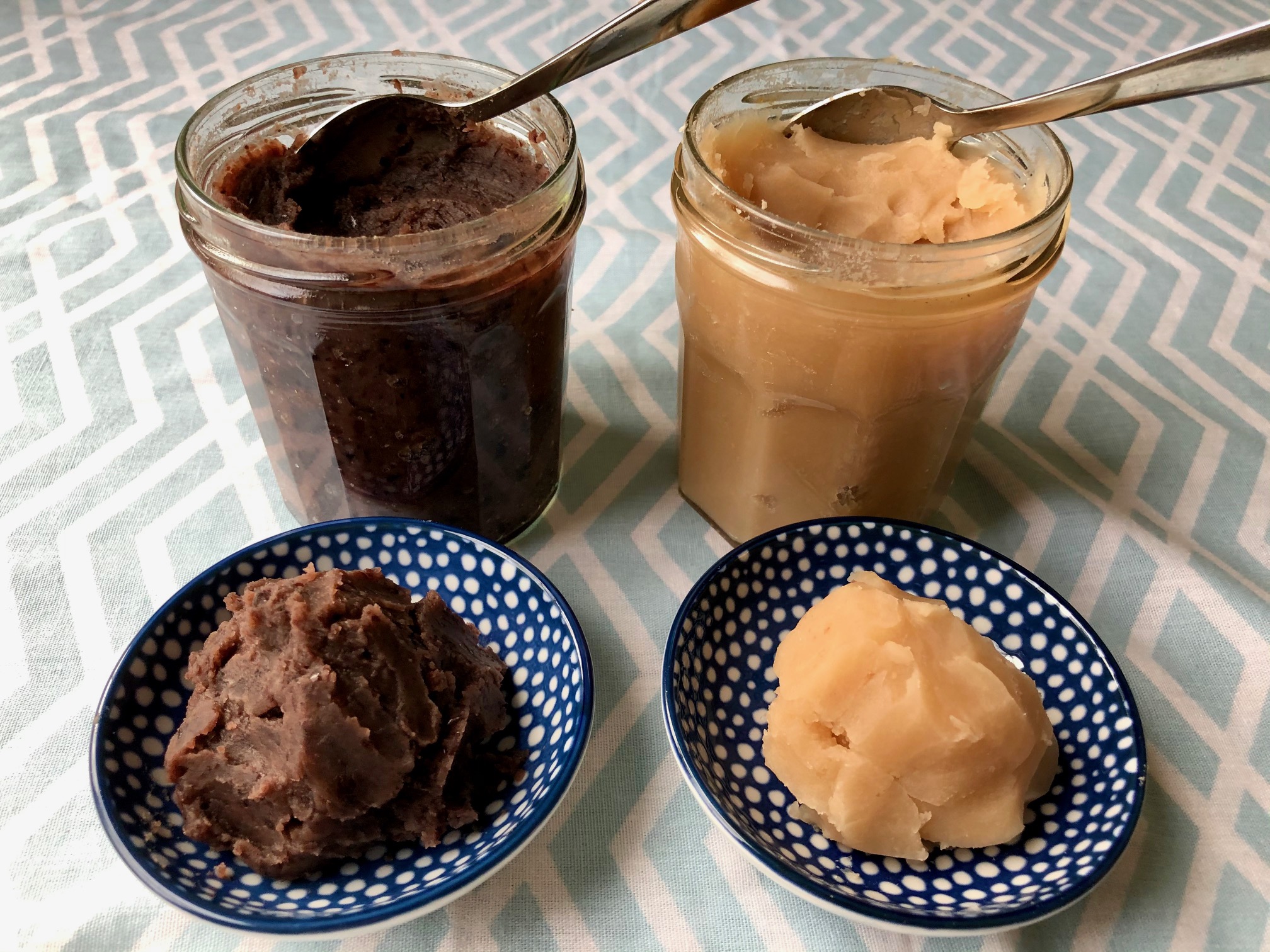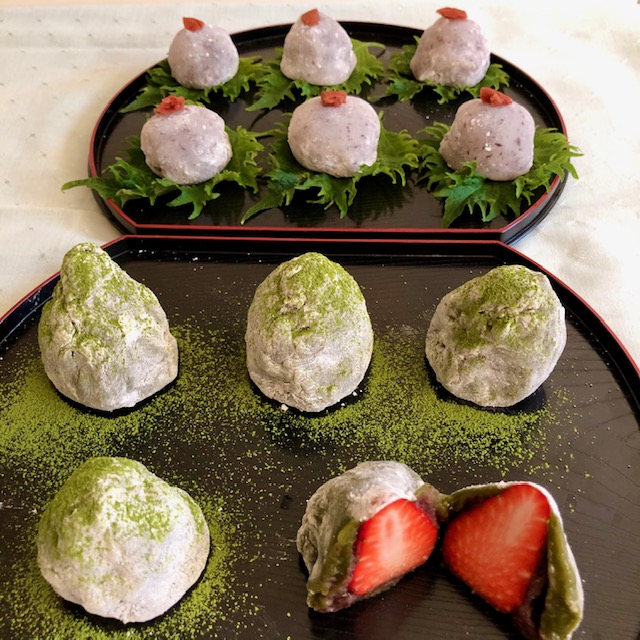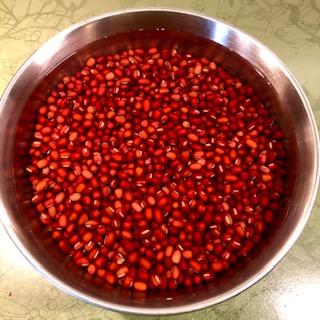Sweet bean paste “anko”

About sweet bean paste “anko”

Sweet bean paste is “anko” or “an” in Japanese and it is indispensable for making “Wagashi” = Japanese sweets. Wagashi are traditional Japanese sweets and are made from plant-based ingredients, such as beans, rice powder, sugar etc. If you have “anko”, you can make Japanese sweets with a little effort.
People who have never made sweet bean paste may find it a little difficult at first. However, it is worth making. Because the sweet bean paste cooked from dried beans has a wonderful bean flavor and is really delicious.
After I started living in the Netherlands, I have started making sweet bean paste myself. Make a lot at once and bottle or freeze. That way, you can easily and quickly make Japanese sweets whenever you want.
If you are interested, please click on the link about nutrition and health benefits of Azuki, which often is used for sweet bean paste.
Sweet bean paste type
Usually, when we talk about “anko”-sweet bean paste, we often refer to azuki bean paste. However, you can make it with white beans as well. Both are equally delicious. In fact, there are other types of sweet bean paste, but I won’t cover them here.
In addition to the type of beans, you can divide them roughly into 3 types according to the texture.
Tsubuan – made without mashing or straining cooked beans and keeping the shape of the beans as much as possible. So you can enjoy the original texture of the beans!
Koshian – made by crushing beans, straining them, and removing the skin from the beans. You can enjoy a smooth texture.
Tsubushian or Zenryuan – made by crushing beans but not removing the skin. Tsubushian is just halfway between Tsubuan and Koshian. I make this with a food processor. It is recommended because you can enjoy the smoothness and taste of beans.
How to make

Now, I will briefly explain how to make it. First, soak the beans in plenty of water overnight. Then let boil the beans and discard water to remove beans astringency. Repeat this twice.
Put the beans in a clean pot and add the water to 1 – 2 cm above beans. When it boils, turn down the heat and simmer gently until beans become very soft. During this time, add water as needed so that beans are always covered with water.
Discard the water again. If you make “Tsubuan”, put beans back in the pot and add sugar and stir constantly over medium high heat until becoming a paste.
To make “Koshian”, crush the beans with a potato masher and then strain to remove the skin. For “Tubushian / Zenryuan”, put beans in a food processor and process until smooth. In both cases, after these processes, put them back in the pot, add sugar and stir until they become a paste.
How to save sweet bean paste
When refrigerating in a container with a lid, it is necessary to use up in a few days as much as possible.
I usually make a lot at once. Therefore, I bottle the portion that I don’t use immediately. Pour hot anko into a sterilized jar and close the lid tightly, just like when bottling jam. When it is cooled, store it in the refrigerator. With this method, the inside is sterilized and it becomes close to vacuum, so you can store it in the refrigerator for 2-3 weeks.
In frozen storage, it seems that you can store it for about 2 months. If you don’t eat for a while, I recommend freezing.
Sweet bean paste – “anko”
Equipment
- a large pot
Ingredients
- 300 gram Azuki or white beans
- 200~250 gram Granulated sugar
- a pinch Salt (only for azuki beans)
Instructions
- Wash the beans and soak them in plenty of water overnight. Drain the water, put the beans in a pot, add fresh water 1-2 cm above the beans, and heat over high heat.

- When it boils, add 1 cup of water. There should be quite a lot of bubbles floating at this stage. When it boils again, simmer the beans for 2 ~3minutes and then turn off the heat.

- Drain the water through a fine strainer and quickly wash the beans with water. Clean the pot, put back the beans, add water 1-2 cm above the beans, and heat over high heat. When it boils, add another cup of water, simmer for 2~3 minutes, and wash with water in the same way as above.

- Put the beans back in the pot, add water 1-2 cm above the beans, and bring to a boil over high heat. When it boils, reduce the heat so the beans dance lightly and simmer until the beans are tender or until you can easily crush the beans with your fingertips. During this time, water is added as needed so the beans are always covered with water. It takes 40-60 minutes for azuki beans and about 2 hours for white beans to soften. (You can also cook the beans in a pressure cooker. In that case, cook azuki for 15 minutes and white beans for 20-25 minutes, turn off the heat, and leave it for about 15 minutes.)

- Remove from heat and drain with a cloth-lined colander or fine mesh strainer.Thubuan – put the beans in a pot and add the granulated sugar in several batches, and stir constantly over medium high heat until becoming a paste. If you use azuki beans, you add a pinch of salt after adding sugar.

- Ttsubushian / Zenryuan – put beans in a food processor and process until smooth.

- Then place the beans in a pot, add sugar in several batches and stir constantly over medium high heat until becoming a paste. If you use azuki beans, you add a pinch of salt after adding sugar.

- Koshian – crush the beans with a potato masher. Place a fine sieve on a bowl and strain beans while pouring water. Remove the remaining bean skin.

- Pour the contents of the bowl into a strainer covered with a cloth

- Squeeze it together with the cloth to drain it well.

- Then place the beans in a pot, add sugar in several batches and stir constantly over medium high heat until becoming a paste. If you use azuki beans, you add a pinch of salt after adding sugar.

- Divide the paste into small amount, and transfer to a container. Let them cool compeletly and use.

Notes
Sweet bean paste goes well with butter and cream. Therefore, it is very delicious to spread it on butter toast or add it to vanilla ice cream. This time I wrote how to make it, but in the future I will post Japanese sweets using sweet bean paste.
There is also a recipe for agar jelly that you can enjoy with anko. Please make it if you like.
Thank you for reading and Bon Appetit !


